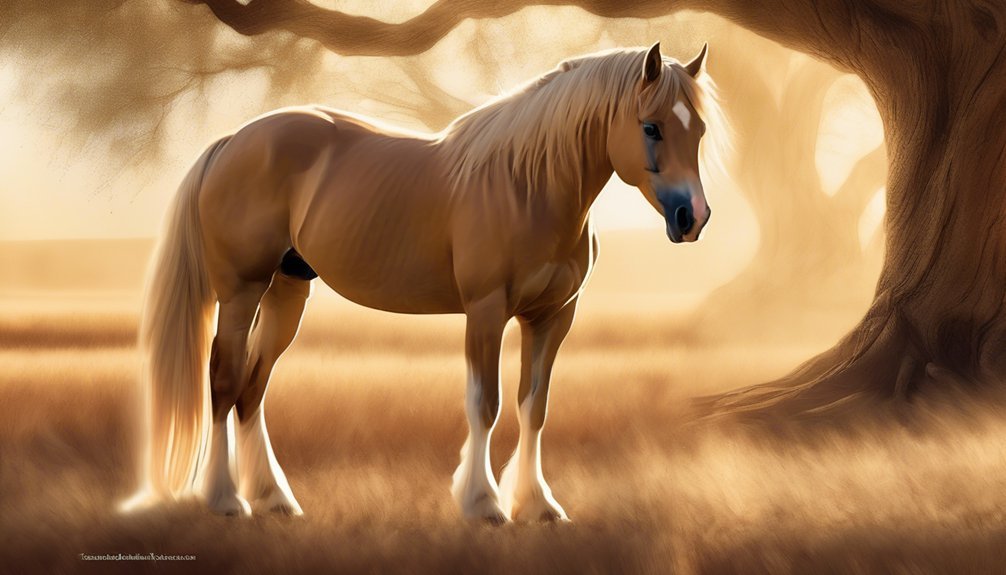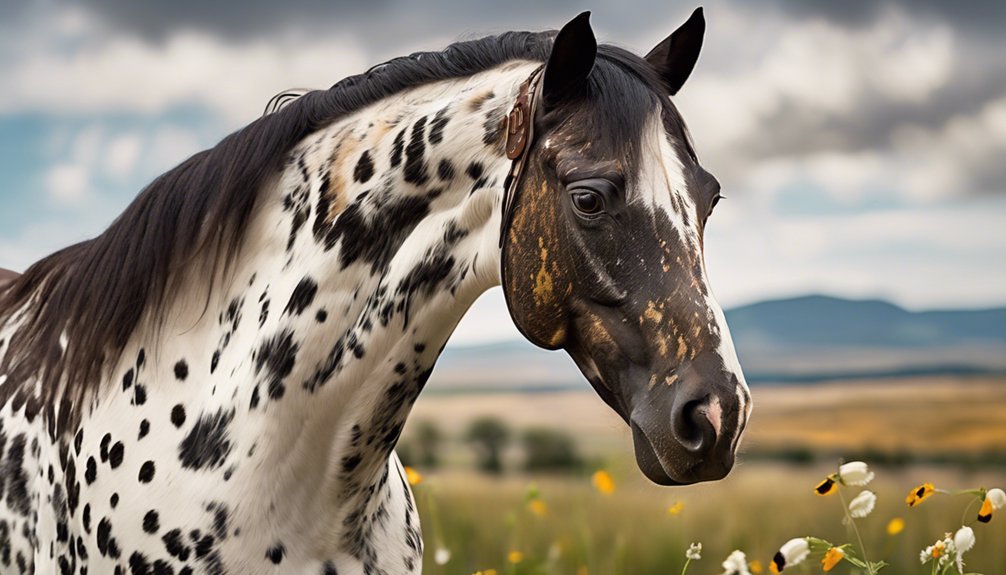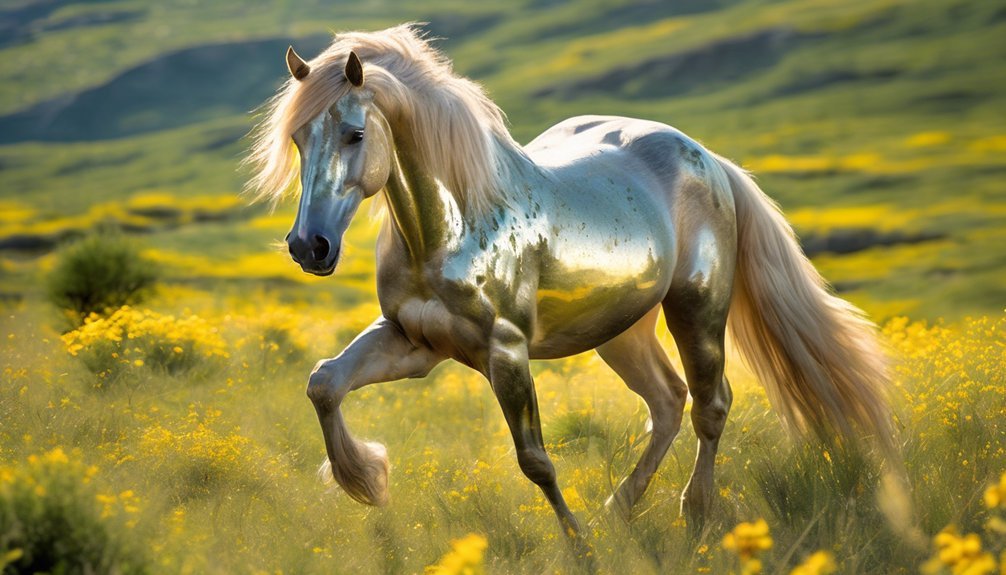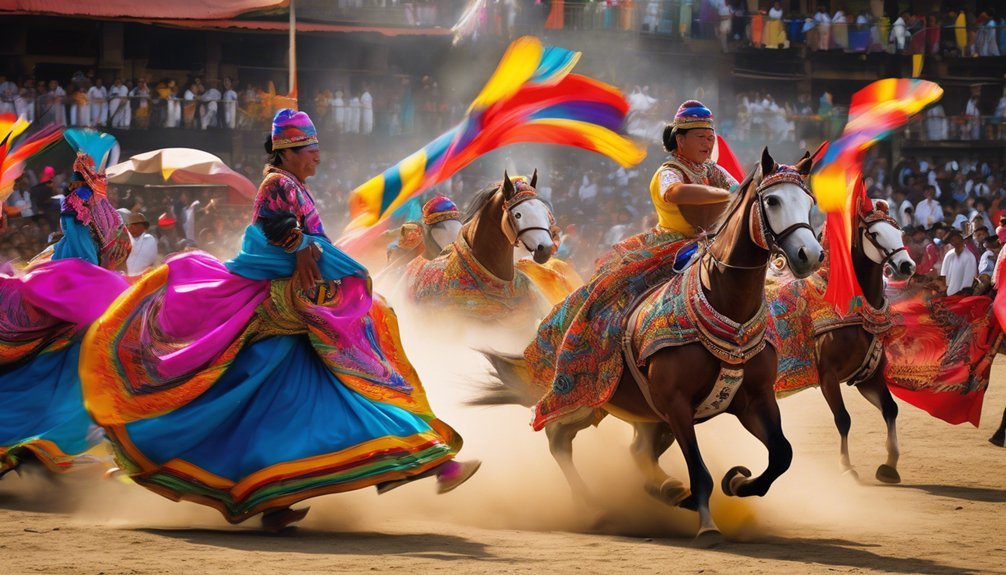
Isn't it intriguing that some of the oldest horse breeds still thrive today? These breeds, like the Arabian and Akhal-Teke, offer more than just beauty; they embody rich histories and unique characteristics shaped by centuries of human interaction. Each breed tells a story of resilience, adaptability, and companionship. As you explore these remarkable horses, you'll uncover the remarkable traits that have allowed them to endure through time. What secrets do these ancient breeds hold?
Key Takeaways
- The Arabian Horse, with roots dating back over 4,500 years, is one of the oldest horse breeds still in existence.
- The Akhal-Teke, revered for over 3,000 years, is known as the "Golden Horse" and originates from Turkmenistan.
- The Appaloosa, recognized for its striking coat patterns, has over 2,000 years of historical significance tied to the Nez Perce tribe.
- The Andalusian breed, with origins in the Iberian Peninsula, has a rich history linked to classical dressage and cultural traditions.
- The Icelandic Pony, known for its unique gaits and adaptability, has been around for over 1,000 years, thriving in harsh environments.
The Arabian Horse: A Legacy of Endurance

When you think of endurance in the equestrian world, the Arabian horse undoubtedly stands out as a pinnacle of strength and resilience. This breed, steeped in rich Arabian heritage, showcases remarkable stamina that's been honed over centuries.
You'll find that Arabian endurance isn't merely physical; it's a testament to their deep-rooted bond with humans. These horses navigate challenging terrains with grace, reflecting their historic role as companions to Bedouins across vast deserts.
Their unique physiology, including a high lung capacity and efficient metabolism, enables them to excel in long-distance events. As you explore their legacy, you'll appreciate how their endurance reflects a harmonious blend of natural ability and centuries of careful breeding, making them truly unmatched in the equestrian realm.
The Thoroughbred: Racing Royalty
When you consider the Thoroughbred, you're looking at a breed with deep historical roots in horse racing that shaped the sport as we know it today.
Their bloodlines and pedigree are meticulously tracked, reflecting a legacy of speed and stamina that continues to dominate racetracks worldwide.
Understanding these elements reveals why the Thoroughbred holds such a revered status in the equestrian world.
Historical Significance in Racing
Although many horse breeds have made their mark in the world of racing, none quite match the prestigious lineage of the Thoroughbred. These remarkable horses not only excel in speed but also embody the rich cultural significance of horse racing itself. Over centuries, they've transformed racing techniques, setting benchmarks for performance and strategy.
| Aspect | Importance |
|---|---|
| Racing Techniques | Ability to sprint and stamina |
| Historical Context | Roots in royal patronage |
| Cultural Impact | Symbol of wealth and status |
| Global Influence | Major presence in international races |
The Thoroughbred's legacy as racing royalty reflects a deep-seated connection between humanity and these magnificent creatures, shaping traditions that resonate today.
Bloodlines and Pedigree Importance
While the allure of the Thoroughbred often lies in their speed and grace, the true foundation of their racing prowess is rooted deeply in bloodlines and pedigree.
Understanding bloodline significance is crucial for any racing enthusiast or breeder.
- Genetic Influence: A horse's lineage can determine its physical attributes and temperament.
- Racing Performance: Pedigree tracking reveals historical data on performance, guiding breeding decisions.
- Market Value: A strong pedigree enhances a horse's desirability and price in the racing industry.
The Icelandic Pony: Unique Gaits and Versatility
The Icelandic Pony stands out for its remarkable gait variations, including the unique tölt and flying pace, which enhance both comfort and speed.
You'll find its adaptability in various environments equally impressive, as this breed thrives in harsh conditions while excelling in diverse disciplines.
Understanding these attributes reveals why the Icelandic Pony isn't just a resilient companion but also a versatile performer.
Distinctive Gait Variations
When considering horse breeds with distinctive gaits, the Icelandic Pony stands out due to its unique ability to perform a variety of movements not commonly seen in other equines.
This breed showcases remarkable versatility through its distinctive gaits, which can be analyzed for their unique movement patterns:
- Tölt: A four-beat lateral gait, allowing smooth, fast movement without losing balance.
- Flying Pace: A two-beat gait that provides speed, particularly useful in racing.
- Walk: A steady and relaxed gait, ideal for long-distance travel.
Gait analysis of the Icelandic Pony reveals a complex interplay of musculature and biomechanics, giving rise to these extraordinary movements.
Understanding these variations not only enhances your riding experience but also deepens your appreciation for this ancient breed's unique heritage.
Adaptability in Various Environments
As you explore the remarkable adaptability of the Icelandic Pony, you'll find that its unique gaits play a crucial role in thriving across diverse environments.
This breed showcases exceptional environmental resilience, allowing it to navigate challenging terrains, from rugged mountains to soft marshes. The tölt, with its smooth and rhythmic motion, enables you to cover ground efficiently, while the flying pace offers speed when needed.
Such versatility not only enhances ride comfort but also exemplifies the Icelandic Pony's breed adaptability. Its ability to adjust to varying climates and conditions demonstrates an innate strength, making it a cherished companion for riders seeking a dependable partner in any setting.
The Icelandic Pony truly embodies the spirit of adaptability in the equine world.
The Andalusian: Grace and Power
Although many horse breeds exhibit beauty and strength, the Andalusian stands out as a paragon of grace and power. This breed's rich Andalusian history intertwines with the artistry of classical dressage, showcasing its natural elegance.
You'll find that their training emphasizes responsiveness and agility, enhancing their innate abilities.
- Renowned for their striking appearance and athleticism
- Versatile in various equestrian disciplines, from dressage to working cattle
- Deep-rooted traditions that celebrate their heritage and cultural significance
As you delve into the nuances of Andalusian training, you'll appreciate how these horses embody the perfect blend of spirit and finesse, making them not just a joy to ride, but also a profound connection to history and equestrian art.
The Akhal-Teke: The Golden Horse
The Akhal-Teke, often referred to as the "Golden Horse" for its stunning metallic sheen, captivates horse enthusiasts with its unique blend of beauty and endurance.
Rooted in Akhal Teke history, this breed hails from Turkmenistan, where it's been revered for over 3,000 years.
You'll find that Akhal Teke characteristics include a slender, athletic build, long legs, and a fine, shimmering coat that reflects light in captivating ways.
Their agility and stamina make them exceptional athletes, excelling in endurance racing and other equestrian disciplines.
With a temperament that ranges from spirited to gentle, these horses develop deep bonds with their owners.
Owning an Akhal-Teke isn't just about having a horse; it's embracing a living piece of history and culture.
The Shire: Gentle Giants of the Past

Few breeds can match the Shire horse in terms of sheer size and strength, making it one of the most impressive draft horse breeds in the world. Known for their towering stature and remarkable Shire characteristics, these gentle giants are a testament to what draft horses can achieve.
- Incredible pulling power, historically used for heavy farm work
- A gentle temperament that makes them great companions
- Distinctive feathering on their lower legs, adding to their majestic appearance
With a history steeped in agricultural tradition, Shires embody a calm demeanor and intelligence, making them suitable for various roles today.
Their unique blend of strength and gentleness continues to endear them to horse lovers around the globe, ensuring their legacy lives on.
The Morgan Horse: American Heritage
While many horse breeds boast rich histories, the Morgan horse stands out as a symbol of American heritage, deeply intertwined with the nation's development. Originating in the early 19th century, the breed reflects American influence through its versatility, strength, and loyalty. The Morgan horse has been a dependable partner in agriculture, transportation, and leisure, shaping the lives of countless Americans.
| Trait | Description | Significance |
|---|---|---|
| Versatility | Excels in various disciplines | Essential for adaptability |
| Temperament | Intelligent and friendly | Builds strong bonds |
| Endurance | High stamina and resilience | Ideal for long rides |
Understanding the Morgan heritage allows you to appreciate its role in America's story, embodying the spirit of hard work and community.
The Highland Pony: Resilience in the Highlands
Among the oldest horse breeds, the Highland Pony exemplifies resilience and adaptability, traits that have enabled it to thrive in the rugged landscapes of Scotland's Highlands.
You'll find these ponies embody the rich Highland heritage, showcasing their strength and stamina against harsh weather conditions.
- Well-suited for rough terrain
- Strong, compact build with a thick mane
- Gentle temperament and intelligence
These pony characteristics make them not only reliable working partners but also cherished companions.
Their ability to endure extreme conditions speaks volumes about their historical significance.
As you delve deeper into their story, you appreciate not just their physical attributes but the spirit of survival they represent, connecting you to generations of the Highland landscape.
The Appaloosa: Colorful History and Culture

The Appaloosa, a breed with roots tracing back over 2,000 years, stands out for its striking coat patterns and rich cultural significance.
Originating from the Nez Perce tribe, these horses were vital for survival, serving in hunting and warfare. Their unique Appaloosa patterns—spotted coats that vary widely—aren't just eye-catching; they symbolize the horse's identity and the tribe's connection to the land.
Each pattern tells a story, reflecting the horse's lineage and the tribe's heritage. Today, the Appaloosa remains a cultural icon, celebrated for its versatility and spirited nature.
As you explore this breed, you'll uncover a legacy that intertwines the artistry of nature and the deep connections forged between humans and horses over millennia.
Frequently Asked Questions
How Do I Choose the Right Horse Breed for My Needs?
To choose the right horse breed, consider your horse activities and how they align with breed characteristics. Evaluate your experience, riding goals, and desired temperament to find the perfect match for your lifestyle and preferences.
What Are the Health Issues Common in Older Horse Breeds?
As you navigate the world of horses, remember that older breeds often symbolize wisdom. Common ailments include arthritis and respiratory issues, affecting their breed longevity. Understanding these helps you provide better care for your equine companions.
How Can I Identify a Purebred Horse?
To identify a purebred horse, you'll want to conduct bloodline verification and pedigree analysis. Examine registration papers closely, ensuring the lineage is documented, and consult breed associations for authenticity and additional insights into the horse's heritage.
What Are the Best Training Methods for Ancient Horse Breeds?
Training ancient horse breeds requires a gentle touch, akin to nurturing a delicate flower. Employ natural horsemanship techniques and positive reinforcement methods to foster trust and build a strong, meaningful bond with your horse.
How Do Climate and Environment Affect Horse Breed Characteristics?
Climate and environment shape horse breed characteristics significantly. You'll notice how climate adaptation influences their coat thickness and behavior, while environmental impact affects their diet and overall health, leading to unique traits tailored to specific conditions.
Conclusion
While some might argue that modern breeds overshadow these ancient horses, their enduring qualities and historical significance remain invaluable. The Arabian, Akhal-Teke, and Icelandic Pony embody centuries of adaptation, partnership, and resilience that modern breeds often lack. By appreciating their unique attributes, you not only honor their legacy but also gain insight into the profound bond between humans and horses throughout history. These breeds aren't just relics; they continue to teach us about strength, endurance, and companionship.





